Swaminarayan Akshardham in New Delhi
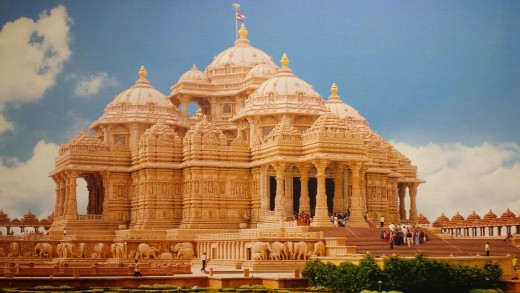
Delhi, the capital of India, is officially known as the National Capital Territory of Delhi or NCT. The city has a humid subtropical climate. Summers are hot and winters are cold.
How to Reach Delhi?
Delhi is well-connected by air, rail and road. The Indira Gandhi International Airport in Delhi, which is spread over an area of 5,106 acres, handles more than 57 million passengers annually. It is the busiest airport in India.
17 Good Hotels in Delhi
5-Star Hotels
|
4-Star Hotels
|
3-Star Hotels
|
2-Star Hotel
|
1-Star Hotel
|
|---|---|---|---|---|
The LaLiT New Delhi
|
Hotel City Park
|
Hotel Kings Inn
|
Hotel Sunstar Heights
|
Hotel Delhi Regency
|
Pride Plaza Hotel Aerocity
|
Premier Inn New Delhi Shalimar Bagh Hotel
|
Hotel Regent Continental
|
Hotel Avtar
| |
Samrat Hotel
|
The Umrao
|
Hotel Waterfall
|
Smyle Inn
| |
Jaypee Vasant Continental
|
The Hans, New Delhi
|
Hotel Le Roi
|
Hotel Amrit Villa
|
There are many historic and modern tourist attractions in Delhi. Here are some of them.
Gurudwara Bangla Sahib
Located next to Grand Post Office, this Sikh place of worship is known for its association with Guru Har Krishan, the eighth Sikh Guru. The complex houses a prayer hall, a water tank, a library, a museum, a hospital, a school and an art gallery.
This Gurudwara was once a bungalow owned by Raja Jai Singh in the 17th century. It was known as Jaisinghpura Palace in those days. When Guru Har Krishan visited Delhi in 1664, was a guest at this bungalow.
There was an outbreak of cholera and smallpox in the region. Many people succumbed to these diseases, which were deadly in those days. Guru Har Krishan cured many people with holy water. Unfortunately he contracted smallpox and died on March 30, 1664. Later the bungalow was converted into a Gurudwara.
This Gurudwara, which is carved out of white marble, is an excellent example Sikh architecture. The Art Gallery displays paintings depicting historical events related to Sikhism.
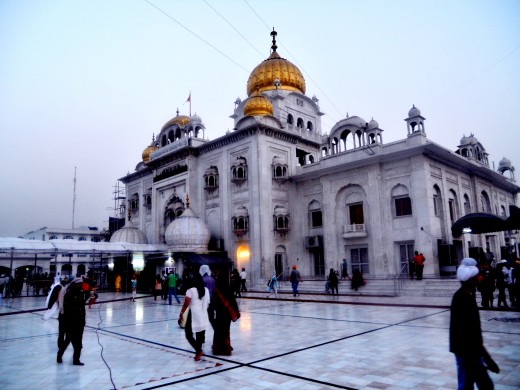
Gurudwara Bangla Sahib Nearest Metro
Patel Chowk.
Swaminarayan Akshardham
This spiritual-cultural campus is located in Pandav Nagar. Akshardham means divine abode. This beautiful place of worship epitomizes 10,000 years of Indian culture in all its breathtaking grandeur, wisdom and bliss.
Swaminarayan Akshardham covers an area of around 8,000 square meters. It blends technical modernity with traditional architectural styles.
Mandir, Hall of Values, Giant Screen Film, Musical Fountain, Garden of India, Boat Ride, Sahaj Anand Water Show and Abhishek Mandap are the main attractions in this complex.
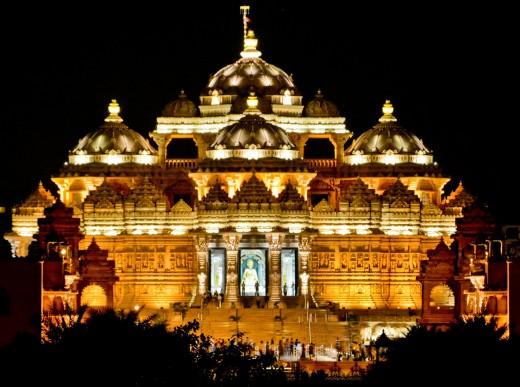
Akshardham Delhi Timings
Opening
|
Closing
|
|---|---|
9.30 am
|
6.30 pm
|
Yogashram
This serene meditation center is located in Ramakrishna Puram (popularly known as R.K. Puram), a central government employees residential colony in South West Delhi.
If you are seeking spirituality, to learn meditation, etc, this place is just right for you. Here you can learn various techniques to relax your body and mind, to refine yourself, to evolve, to grow as a human being.
A
Awesome spiritual atmosphere.
— Krishh YuvaRashtrapati Bhavan
Rashtrapati Bhavan, the official residence of the President of India, is spread across 320 acres and consists of 340 rooms.
India Gate
India Gate is a war memorial located astride the Rajpath. This 42-m-high "Arc-de-Triomphe" like archway was inaugurated under the Viceroy ship of Lord Irwin.
Humayun's Tomb
Humayun was the second Mughal Emperor. He ruled between 1530 and 1540. He died in 1556. His first wife and chief consort Bega Begum commenced the construction of the tomb in 1569.
Humayun's Tomb (or Makbara-e -Humayun) was designed by Mirak Mirza Ghiyas, a famous Persian architect. The structure was inspired from the tomb of the Persian Mongol ruler, Oljeytu, at Sultaniyya.
The tomb is an excellent example of Mughal architecture. In fact it is the starting point of the Mughal architecture in India. The mausoleum itself stands on a high, wide terraced platform with two bay deep vaulted cells on all four sides.
It has an irregular octagon plan with four long sides and chamfered edges. It is surmounted by a 42.5 meter high double dome clad with marble flanked by pillared kiosks (chhatris) and the domes of the central chhatris are adorned with glazed ceramic tiles. The middle of each side is deeply recessed by large arched vaults with a series of smaller ones set into the facade.
The cost of construction of this tomb was ₹1.5 million. It was the first garden-tomb on the Indian subcontinent. It inspired many major architectural innovations, culminating in the construction of the Taj Mahal.
Located in Nizamuddin, East Dehli, near the crossing of Mathura road and Lodhi road, Humayun’s tomb is one of the best preserved Mughal monuments. It was declared a UNESCO World Heritage site in 1993.
Humayun's Tomb Facts
- Humayun's Tomb Facts
Everything you always wanted to know about Humayun's tomb.
Qutb Minar
Qutub Minar Information
Qutb Minar is a part of the Qutb complex, a UNESCO World Heritage Site. This 73-meter-high minaret, the tower of victory, was built in 1193 by Qutab-ud-din Aibak after his victory over Delhi's last Hindu kingdom. Construction was started by Qutb ud-Din Aibak and completed by his successor and son-in-law Iltutmish.
Qutb Minar is in Indo-Islamic architecture. Built with red sandstone and marble, this imposing monument is the tallest brick minaret in the world. It has a diameter of 14.32 meters at the base and about 2.75 meters on the top. It is a five story structure. There are flights of 379 steps which you have to cover to reach to the top.
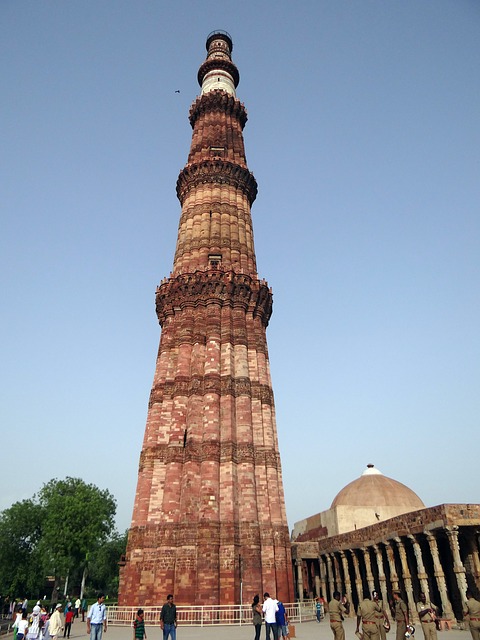
Lotus Temple
Located in Kalkaji (east of Nehru Place), this wonderful Bahá'í House of Worship that was built in 1986; more than 70 million people have visited it since then.
Designed by Canadian architect Fariborz Sahba, it is famous for its beautiful lotus shape. The Lotus is a symbol of peace and the temple embodies that spirit. It is surrounded by lush green landscaped garden, known as Shambhu Dayal Bagh.
The building is made up of pure white marble. There are nine doors, all of which lead to one central hall, which can accommodate around 2000 people. Inside the temple, the ribs of the petals interlock with each other, thereby creating a net-like structure.
There are no statues, idols, pictures or scriptures inside the premises, yet it binds all the visitors with its aesthetic value. Though ordinary in its style, it culminates in producing a striking effect. There are nine pools of water around the petals, which light up in natural light. The whole place is a treat to the eyes when it is flood lit in the night.
I like this temple because it propagates the oneness of God. It is open to all regardless of their nationality, religion, race or gender. You can just walk in, sit, meditate or pray silently.
You need not pay anything to enter this architectural marvel, which is open on all days of the week except Monday. Around 10,000 people visit the temple in a day.
Timings:
October-March: 9.30 am - 5.30 pm
April-September: 9.30 am - 7.00 pm
Red Fort
This historic fort was the main residence of the emperors of the Mughal dynasty for nearly two centuries. Construction of Red Fort started in the year 1639. It took eight years to build this UNESCO World Heritage Site. It is open on all days (except Mondays) between 7.00 am and 5.30 pm.
Red Fort
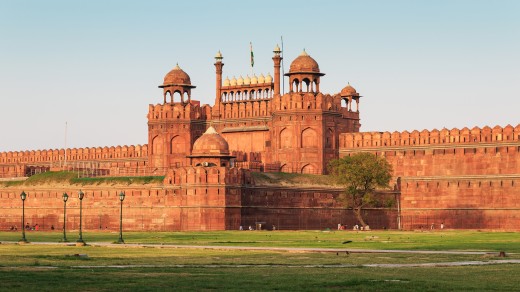
Red Fort Information
Architect
|
Ustad Ahmad Lahori
|
Architectural style
|
Indo-Islamic
|
Construction commissioned on
|
12 May 1639
|
Construction completed on
|
6 April 1648
|
Area
|
254.67 acres
|
Length of defensive walls
|
2.41 kilometers
|
Main gate
|
Lahori Gate
|
Red Fort was designated a UNESCO World Heritage site in 2007.
Laxminarayan Temple
Located in Mandir Marg near Gole Market, this beautiful Hindu temple is also known as Birla Mandir.
No comments:
Post a Comment